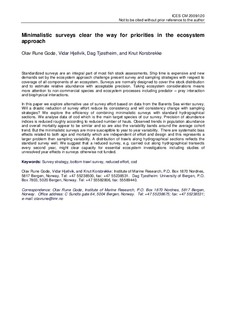| dc.contributor.author | Godø, Olav Rune | |
| dc.contributor.author | Hjellvik, Vidar | |
| dc.contributor.author | Tjøstheim, Dag | |
| dc.contributor.author | Korsbrekke, Knut | |
| dc.date.accessioned | 2012-02-07T08:12:41Z | |
| dc.date.available | 2012-02-07T08:12:41Z | |
| dc.date.issued | 2009 | |
| dc.identifier.citation | This report is not to be quoted without prior consultation with the General Secretary. | no_NO |
| dc.identifier.uri | http://hdl.handle.net/11250/102952 | |
| dc.description.abstract | Standardized surveys are an integral part of most fish stock assessments. Ship time is expensive and new
demands set by the ecosystem approach challenge present survey and sampling strategies with respect to
coverage of all components of an ecosystem. Surveys are normally designed to cover the stock distribution
and to estimate relative abundance with acceptable precision. Taking ecosystem considerations means
more attention to non-commercial species and ecosystem processes including predator – prey interaction
and biophysical interactions.
In this paper we explore alternative use of survey effort based on data from the Barents Sea winter survey.
Will a drastic reduction of survey effort reduce its consistency and will consistency change with sampling
strategies? We explore the efficiency of combining minimalistic surveys with standard hydrographical
sections. We analyse data of cod which is the main target species of our survey. Precision of abundance
indices is reduced roughly according to reduced number of hauls. Observed trends in population abundance
and overall mortality appear to be similar and so are also the variability bands around the average cohort
trend. But the minimalistic surveys are more susceptible to year to year variability. There are systematic bias
effects related to both age and mortality which are independent of effort and design and this represents a
larger problem then sampling variability. A distribution of trawls along hydrographical sections reflects the
standard survey well. We suggest that a reduced survey, e.g. carried out along hydrographical transects
every second year, might clear capacity for essential ecosystem investigations including studies of
unresolved year effects in surveys otherwise not funded.
Keywords: Survey strategy, bottom trawl survey, reduced effort, cod | no_NO |
| dc.language.iso | eng | no_NO |
| dc.publisher | ICES | no_NO |
| dc.relation.ispartofseries | ICES CM documents;2009/I:20 | |
| dc.subject | bottom trawl | no_NO |
| dc.subject | bunntrål | no_NO |
| dc.subject | cod | no_NO |
| dc.subject | torsk | no_NO |
| dc.title | Minimalistic surveys clear the way for priorities in the ecosystem approach | no_NO |
| dc.type | Working paper | no_NO |
| dc.subject.nsi | VDP::Agriculture and fishery disciplines: 900::Fisheries science: 920::Resource biology: 921 | no_NO |
| dc.source.pagenumber | 17 s. | no_NO |
